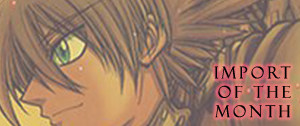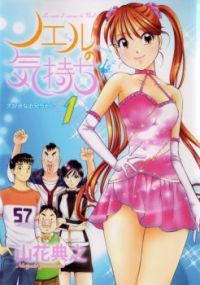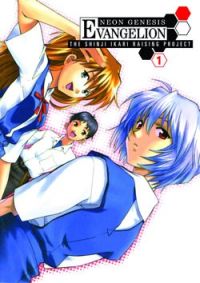RIGHT TURN ONLY!!
Ultimo's Sweet Home
by Carlo Santos,

Hey kids! Comic-Con!
Will you be attending this year's San Diego Comic-Con? If so, make sure to stop by the Best and Worst Manga of 2010 panel on Thursday, 4:30 pm (Room 3), where I will be co-hosting along with a bunch of other people who are smarter and cooler than me. You've read my words in this column, now see me tell it to your face! IF YOU GO TO JUST ONE PANEL AT COMIC-CON ... well, you should probably go see the Scott Pilgrim one instead. But I'd rank this a close second.
CHI'S SWEET HOME

Vol. 1
(by Konami Kanata, Vertical, $13.95)
FROM THE BACK COVER:
"Chi is a mischievous newborn American shorthair who, while on a leisurely stroll with her family, found herself lost. When we found Chi it was clear to us she was completely distraught as she longed for the warmth and protection of her mother. Feeling sympathy for the little furball, we quietly whisked her away inviting her into our small apartment home ... where pets are strictly not permitted. While we dread parting with her, there is no way she can stay.
Little Chi is a happy and healthy litter-box trained kitten. And while she can be a little bit of a handful, she has been a great source of joy in our lives and a wonderful companion to our young son. Living with Chi has completely changed our lives, and are we sure she will have the same impact with whomever gives her a good home."
EVIDENCE FOR:
There's cute, and then there's "AAAHHH! KITTIES!" cute. Chi is clearly of the second variety, with its endearing tales about the everyday adventures of a recently-adopted stray kitten. The nonchalant, meandering quality of each chapter perfectly mirrors a cat's own thought processes: going in whichever direction it pleases, content to let things develop naturally. Even at this pace, though, there are plenty of opportunities for humor—like Chi making playthings out of various objects around the house, or the constant struggle of toilet-training, or the shock of going to the vet, or even the worry of being discovered by the nosy neighbors. At the same time, there are also remarkable moments of poignancy, including Chi's memories and dreams of her mother, and her frequent attempts to escape and go home. It is that little thread of longing, woven throughout the series, that makes this deeper than one might expect. The artwork, meanwhile, is utterly clear and straightforward in conveying the story: there is never any confusion as to what Chi is up to, whether she's asleep, or playing, or just loafing around the house. The simple linework and full-color illustration make it very pleasing to the eyes ... and to the heart.
EVIDENCE AGAINST:
Although it calms the mind and soothes the soul, Chi's level of charm really only scratches the surface, and fails to engage in a more serious way. The stories, ultimately, are typical how-to-raise-a-cat fodder: feeding, bathing, toilet-training, medical check-ups, and keeping the creature entertained. It may be cute to read, but the humor is bland at best, about equal to the pleasure one gets out of vacuuming the house or doing the dishes. The linearity of the series doesn't help either—oh, sometimes you get some intrigue, like the folks next door possibly discovering that Chi is being kept in the apartment, but any possible plot twists are quickly diffused by gimmicky clichés ("Ha ha, it was just a stuffed toy!"). Aside from that, it's just Chi-does-this, then Chi-does-that, and so on until the book is tossed aside from sheer boredom. Even the memories of Chi's mother aren't all that effective, because after using that plot device a couple of times, it never develops further. Will Chi ever have a chance of being reunited with her family? It's hard to say, when the series is only slightly more sophisticated than Garfield.
FINAL VERDICT:
For cat lovers, and for those who are sick of fantastical action-adventures or melodramatic romances, this is a refreshing choice—but still only a C+ for lack of real substance.
FULLMETAL ALCHEMIST

Vol. 23
(by Hiromu Arakawa, Viz Media, $9.99)
FROM THE BACK COVER:
"In an alchemical ritual gone wrong, Edward Elric lost his arm and his leg, and his brother Alphonse became nothing but a soul in a suit of armor. Equipped with mechanical 'auto-mail' limbs, Edward becomes a state alchemist, seeking the one thing that can restore his and his brother's bodies ... the legendary Philosopher's Stone.
As the battle for Central City rages on, Alphonse faces off against Pride and Kimblee with the aid of a Philosopher's Stone. Can he come up with a plan to take down these two dangerous foes? Meanwhile, Ed and his friends run into Envy below the city. When Roy Mustang learns the truth about Hughes's murder, will he be consumed by hatred and do the unthinkable...?"
EVIDENCE FOR:
You want to see some real alchemy in action? Consider that Volume 23 of Fullmetal Alchemist opens with three major battles going on: Al vs. Pride and Kimblee, the Armstrongs vs. Sloth, and Ed vs. the underground, and practically all of them are evenly matched. Perfect chemical equilibrium. Whether it's the power of Philosopher's Stones, or sheer physical strength, or alchemical finesse, each fight is a nonstop barrage of thrills. Things get really interesting at the halfway point, though, when Roy confronts Envy and we get to see the battle that outranks all other battles: Mustang versus his own conscience. It's a scenario that brings up important events from the past—Hughes gets a name-check, as does the Ishbal massacre—and proves just how thoroughly well-rounded the entire saga is. If that's not proof enough of the skillful plotting, just wait until a passing housewife makes her dramatic comeback! Amidst these complex threads of story, though, it's still the slick, distinctive artwork that anchors everything—the blurs of speed between Alphonse and Pride, the power-packed maneuvers of Alex Lous Armstring, and even Roy's burning glare of hatred when he faces Envy for the final time. It's drama, it's action, and it's perfect.
EVIDENCE AGAINST:
It also could have been better ... if the entire first half of this book hadn't been one endless fight scene. Sure, the scenery changes every now and then, but all that really means is having a different set of characters blasting special effects at each other. After a while, all the flying rubble and clouds of dust just get tiresome. And how many times is Arakawa going to pull the "random character you haven't seen in ages miraculously saves the day!" card? Sometimes it's cool, but sometimes it's damn near Three Stooges material, like when Yoki comes busting in with his jalopy. At the same time, all this bluster causes some of the finer plot points to be overshadowed—like the radio station's clever ploy involving President Bradley's wife, or how the Northern troops got their heavy machinery all the way to Central. It's hard to appreciate the subtleties of FMA when there are explosions and transformations drowning out everything else. The greatest disappointment, though, may be Envy's whiny monologue and finale, which kind of proves that he was a lame villain after all.
FINAL VERDICT:
This volume may be too front-loaded with fight scenes, but there are still enough vital plot points—not to mention the entire Mustang sequence—to earn it a powerful, butt-kicking B+.
MAID SAMA!

Vol. 5
(by Hiro Fujiwara, Tokyopop, $10.99)
FROM THE BACK COVER:
"Misaki gets involved in Sakura's love life when she's invited along to meet Sakura's favorite band. But when Sakura's crush is more interested in everyone's favorite maid-in-hiding than Sakura herself, it's up to Usui to intervene! And when the heir to a restaurant conglomerate makes an offer to buy the café, how far will Misaki go to save Café Latte?!"
EVIDENCE FOR:
I believe that all Maid Sama! fans, deep in their hearts, secretly wish that Misaki and Usui never get together. Why? Because they are so awesome when they're at odds at each other. (Of course, that doesn't stop us from enjoying moments of tenderness between them, like when Usui falls ill.) The chemistry between the two has been so perfected that Hiro Fujiwara no longer even needs to be explicit about the tug-of-war relationship between them: she just sets up a hilariously convoluted scenario, like Misaki's cross-dressing scheme to prevent the Butler Café takeover, and then lets the situation speak for itself when Usui and Misaki cross paths. Truly, this is the pinnacle of character-driven comedy: that it's already funny before you even deliver the punchline. This volume also does a great job of bringing other characters into the fray during the Butler arc, whether it's screwball schoolmates or wacky co-workers from the café. As always, the visuals flow smoothly from scene to madcap scene, but they're at their absolute best when the panels open up wide, capturing those big heart-stopping moments between Misaki and Usui. It's romantic, and comedic, and does both well—truly a rare quality.
EVIDENCE AGAINST:
The first chapter of this volume is everything that's wrong with Maid Sama!: too much dialogue, a poorly developed supporting cast, and a plotline that really doesn't bring anything new to the table. It may seem tolerable at first—oh, Sakura and Misaki hang out with some cute rocker guys, things turn sour, Usui comes to the rescue—but its weaknesses soon become evident when placed in the shadow of the much more ambitious Butler Café arc. Cutesy little one-off chapters with generic high school drama just don't cut it when this series has proven in the past that it's capable of much more. Meanwhile, the continuing overuse of dialogue is one of the major stumbling blocks throughout this volume; the action in the middle chapters never really takes off because people are always too busy talking. Even when the main characters are doing something that requires little to no dialogue (like getting dressed?), someone off to the side still has to be making comments. The series also continues to suffer from unimaginative character designs—seriously, with all the random-faced bishounen milling about as side characters, they could start an entire boy band already.
FINAL VERDICT:
Although not perfectly crafted, this volume still takes readers on one delightful ride through the whole Butler Café dilemma. Factor in the heart-tugging Misaki-Usui moments as well and it's enough to earn a B.
MOYASIMON

Vol. 2
(by Masayuki Ishikawa, Del Rey, $10.99)
FROM THE BACK COVER:
"Tadayasu's odd ability to see germs with the naked eye has come in handy for lectures on exotic (and stinky) fermented foods and sake. However, he's going to need more than his natural gifts to survive the university's spectacular Spring Festival. Only great perseverance and a bit of luck will get him through a harrowing competition to achieve the grand prize—a night of attempted debauchery."
EVIDENCE FOR:
What really makes Moyasimon shine is that it's more than just a repository of microbiological trivia (although it does that part really well)—it also happens to be this insane stream-of-consciousness piece about the ups and downs of college life. Just when you thought the characters from Volume 1 were weird enough, here comes a walking cloud of germs, a world-traveling student who's picked up every possible strain of food poisoning, and—in the Spring Festival arc—a whole cabal of mysterious students conspiring to punk Tadayasu and the rest of his buddies. In fact, the entire Spring Festival is a paean to nutty college rituals, with its bizarre reality/game-show elements and a soaring tongue-in-cheek finale. The front half of this volume isn't so bad either, dishing out some vital knowledge about various forms of sake. In the meantime, Masayuki Ishikawa shows improved artistic confidence, with lots of careful shading to bring out the depth and texture in each scene, as well as distinctive character designs for each of the newcomers. But it wouldn't be Moyasimon without the swarms of super-cute microbes, who totally steal the show when they get an entire chapter to themselves—thus being educational AND adorable.
EVIDENCE AGAINST:
How is it that a series so creatively weird and wacky can be so lacking in dramatic impetus? It's clear that Moyasimon has no shortage of great ideas—but lining up those ideas with some kind of purpose seems to be a challenge. Yes, we have a wonderful cast of characters in a unique environment, but slice-of-life humor quickly loses its shine if it just goes around in circles. What's the point of going to the next page, or next chapter, if all that happens is more crazy college students talking about germs and stuff? That's exactly what bogs down the first half of the volume: it may be a great treatise on sake brewing, but it also relies too much on idle dialogue scenes. Only when world-traveling student Aoi shows up does this story arc really show signs of life. Even the Spring Festival segment, despite its definite structure and goals, has a feel of "We're making this up as we go along"—at some point they just start packing on all these arbitrary game-show rules, for no other reason than because college kids are crazy.
FINAL VERDICT:
Yeah, yeah, it's not terribly logical or organized, but as far as sheer charm and character, you can't argue that it reaches at least B+ levels.
ULTIMO

Vol. 2
(by Stan Lee and Hiroyuki Takei, Viz Media, $9.99)
FROM THE BACK COVER:
"Ultimo and Vice are Karakuri Dôji, the mechanical embodiment of pure good and pure evil, devoid of human emotions that can cloud one's judgment. Their purpose: to battle to the death to prove once and for all whether good or evil is the most powerful force in the universe.
Things just keep getting more complicated for Yamato since Ultimo showed up. Now Yamato and Ultimo must face new dôji and deal with people whose intentions aren't always so clear. Can Yamato find the strength to meet these challenges and solve the mysteries of the Karakuri Dôji?"
EVIDENCE FOR:
The battle of good and evil rages on ... and it has so many gray areas, which is what makes Ultimo fascinating. If Volume 1 was about laying out some big ideas about morality, then Volume 2 is the one that actually starts to put those ideas into action, beginning with a battle sequence where a villain does the right thing (shock!) and Ultimo shows surprising signs of ruthlessness (double shock!). The best part, though, is in the middle chapters when new characters start showing up: Stan Lee is clearly having a ball playing with the themes of the Seven Sins and Seven Virtues (although it's somehow condensed to six), while Hiroyuki Takei is having the time of his life designing the characters to match. Good versus evil just gets that much cooler when you have entire teams of fantastical warriors getting into the fray. Takei also has a few tricks up his sleeve for the main hero, borrowing from the tradition of combining and transforming robots. The spindly, delicate linework also adds a certain elegance that one might not expect from a beat-'em-up hero series—and that, among other things, is why Ultimo stands out.
EVIDENCE AGAINST:
The only real reason Ultimo stands out is because it has become yet another vehicle for Stan Lee's insufferable ego. The self-insertion and self-promotion isn't as bad as in Volume 1, but his overbearing presence can still be felt as the mad genius Dunstan who created all these mechanical virtues and vices in the first place. The ultimate result of this ego-stroking is a plotline that is more spectacle than story—just shove in as many cool characters as possible, have them battle it out, and to hell with development. That certainly seems to be the plan as Ultimo and friends mince about getting into scuffles with various forms of the Seven Sins (which, by the way, is near-impossible to do these days without eventually ripping off Fullmetal Alchemist—here it happens when they get to Gluttony). When they do try to add complications to the plot, it always ends up sloppy, with lots of characters standing around talking while the poor reader has probably started to doze off at all this roundabout dialogue. And goodness gracious, the human characters are all stupid-looking (like rejected Shonen Jump protagonists) compared to the mechanical dolls. Why so inconsistent, Takei-sensei?
FINAL VERDICT:
Despite Stan the Man's best efforts to hype this up as something special, it really is just a middle of the road action-hero title, that kind that C- grades are reserved for.

NOEL NO KIMOCHI

Vol. 1
(by Noriyuki Yamahana, Shueisha, ¥514)
FROM THE BACK COVER:
"The princess of the figure skating world, Noel Tsukioka, has been very busy with high school exams while skating at the age of 15. This spring, the World Junior contender finally enters the school where her beloved brother works. She is starting an enjoyable school life. However, a beautiful teacher is approaching her brother Naoto! Is she super jealous? And there is an unspoken secret between Naoto and his younger sister ... are they really not brother and sister?!"
EVIDENCE FOR:
Noel no Kimochi doesn't do any one thing particularly well—rather, it does a little bit of everything well. Part slice-of-life drama, part sports saga, and part cheesecake romance, this title pretty much nails down all the elements that have earned it a place in Business Jump magazine (which is what you graduate to after the Shonen and Young flavors of Jump). The most intriguing plot element, of course, is twentysomething protagonist Naoto lusting after his 15-year-old not-blood-related sister—I mean, if you want to talk about forbidden love, this thing is smashing taboos left and right. Yet there is also an uneasy longing in the way the characters regard each other, and the emotional tension only grows when one of Naoto's fellow schoolteachers takes an interest in him. The end result is a sweet (if scandalous) romantic tug-of-war, also buffeted by outside forces like Naoto's job duties and Noel's figure-skating aspirations. The graceful skating scenes show a strong command of dynamic artwork—at once powerful, yet beautiful to look at—and the quieter dialogue scenes in between also carry their own visual appeal. Then again, maybe that's just because Noel herself is gorgeously drawn; her attractiveness and charm often steal the show in this bittersweet drama.
EVIDENCE AGAINST:
While everyone's busy being distracted by the touchy-feely emotions and societal taboos, the actual plot is getting a free pass for its poor, formulaic construction. Yet if you pay attention to that one ridiculous chapter where the 3rd-year girls want to hang out with Naoto for lunch, Noel no Kimochi's true form becomes clear: it's just another damn harem. Except the main character is a working professional, and one of the potential relationships could send him to jail. So basically, Naoto is just another cookie-cutter male lead with way too many hot girls to choose from, a fact that is further reinforced by his goofy (read: horribly unfunny) colleagues who keep making inappropriate remarks about Noel. So this is what happens when you graduate to titles that run in Business Jump: little boys don't grow up into men, they just grow up into bigger boys. Nowhere is this more obvious than in the blatant Noel fanservice where she is seen in skintight skating outfits, taking up a full page or even more, just to keep readers' eyes hooked. Crude and more than a little bit skeevy? Yep. But whatever keeps the series going...
FINAL VERDICT:
It's readable for the sweet, heartfelt parts and the attractive artwork, but can't be taken too seriously due to the obvious fanservice elements.

What's more fun than going through old favorites? Going through alternate-universe versions of old favorites! This week, our guest reviewer Eric P. offers his thoughts on one of the many Evangelion spinoffs floating in the ether.
NEON GENESIS EVANGELION: THE SHINJI IKARI RAISING PROJECT

(by Osamu Takahashi, original concept by GAINAX, Dark Horse, $9.95 ea.)
The Angelic Days manga had long been bashed for having terrible artwork, a messy story, and just not doing Evangelion or its fans justice. However, I would love to think that once these same critics check out Dark Horse's hyped release of The Shinji Ikari Raising Project, they would say, "Hmm—what was I so mad about Angelic Days for? Considering it's out of print, I sure hope someone does a license rescue for it."
And here's why—despite what flaws it may have had, Angelic Days got the story rolling, cut right to the point, and the relationships between the characters were all believable, at just only 6 volumes. In comparison, the much longer-running Raising Project is almost pure romantic-comedy BS that goes almost nowhere. The romantic relationships feel more artificial, and Shinji doesn't quite have the substance he did in Angelic Days to justify Asuka losing all her dignity in obsessively fighting for his attention. You know that old clichéd scene where a girl falls on top of a guy or vice versa, an awkward moment bound to lead to romance? In just the first 3 volumes, I swear, this happens between Shinji and Rei about 5 freaking times! And there's just a tint of homophobia when Asuka and Rei notice Shinji's taking to Kaworu's flirting and try to save and keep him on the "straight path."
What really makes each volume worth reading is "Misato's Fan Service Center," covering a wide range of topics including everything Evangelion (especially the Rebuild films), Gainax, and the Anime/Manga industry in general. If anything, the editorial really is more interesting than the manga itself.
Now that that's all out of the way—despite all the negativity of this review, I confess that I'm still following this manga regardless. I'm a casual Eva fan, and it's still fun and entertaining to read about these characters in another world where they don't come from screwed-up backgrounds and won't meet twisted fates. Here we get to see Gendo as a hapless, comedic father which is good for a few chuckles, and we actually get to meet Asuka's mother. And each volume makes the smallest revelation that the story is just maybe about getting somewhere, just not fast enough. So this is a snack-manga best enjoyed in small doses, and I'm still looking forward to Dark Horse's release of Campus Apocalypse (as well as Viz licensing the final volume of the official Evangelion manga).
Is there a hidden gem of manga you'd like to reveal to the world? Is there a piece of garbage that deserves to be bashed in public? Or is there a title that didn't get a fair grade here, and you want to set the record straight?
Now's YOUR chance to be the reviewer! Write a review of about 300-400 words (a little more or less is fine) and include:
- Your name
- Title of manga (and volume no., if applicable)
- Author/Artist
- Publisher
- Briefly describe the story, then explain why this manga is great, terrible, or in between. Be objective, but also be entertaining.
Then send it in to rtoreaders (at) gmail (dot) com (plain text format preferred). One review will be selected out of all the submissions and will be published in the next column. All types of manga and manga-inspired comickry are accepted, from past and present, from Japan and beyond—what matters is that it's the Reader's Choice! NOTE: Submissions may be edited for formatting and grammar.
discuss this in the forum (8 posts) |